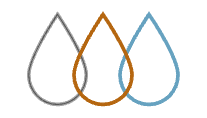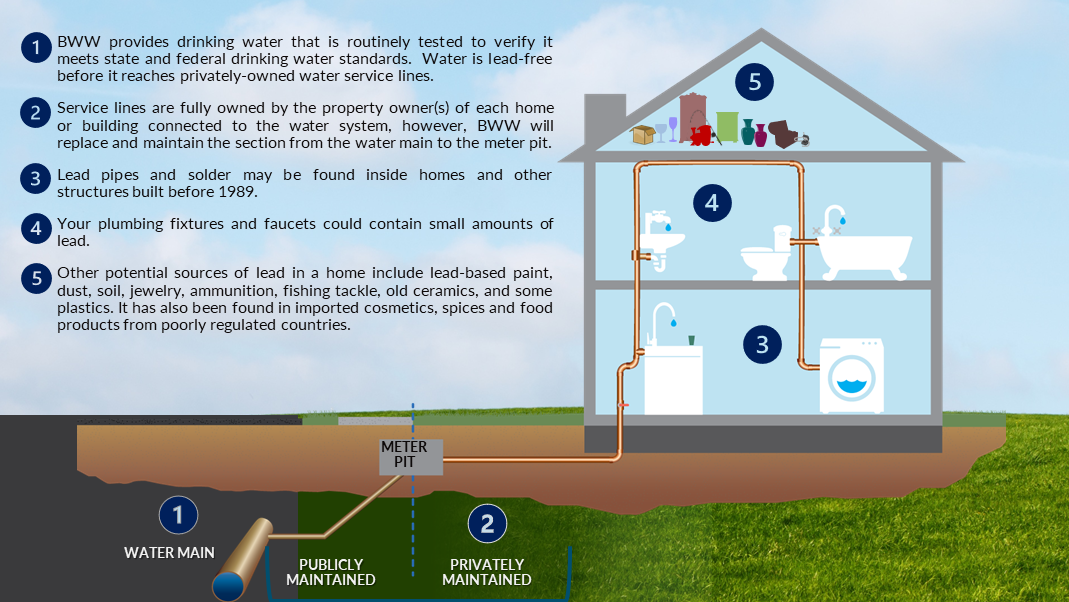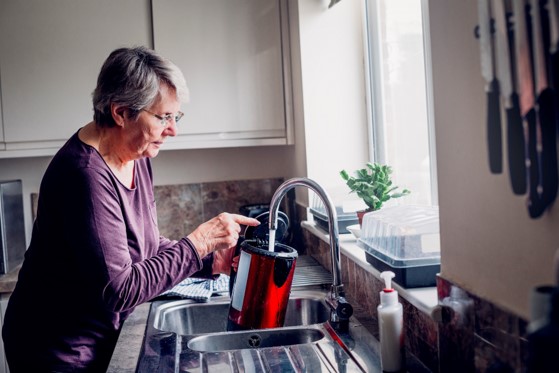Understanding Your Water Service Line Notification Letter
Why did I receive a letter about my service line?
 New USEPA regulations require us to notify all customers served through a water service line made of lead (Pb), galvanized steel that is or was downstream of lead, or unknown materials. It is meant explain the health risks of lead exposure, share simple precautions that can be taken to minimize any, and where to find more information about lead safety.
New USEPA regulations require us to notify all customers served through a water service line made of lead (Pb), galvanized steel that is or was downstream of lead, or unknown materials. It is meant explain the health risks of lead exposure, share simple precautions that can be taken to minimize any, and where to find more information about lead safety.
The letter does not mean that lead is present in your drinking water. USEPA requires all public water systems to send this notification to customers annually starting this fall. New customers will also receive a copy when they begin service. You will continue to receive a copy of this letter each year until your service line is replaced, or if it is unknown, until the material is confirmed to be non-lead.
Is my water safe to drink?
Yes. The Birmingham Water Works treats, tests, and distributes high-quality drinking water to you and the community. Water provided by BWW water is lead (Pb)-free when it leaves our treatment plants, and our water mains (the pipes that distribute water throughout the community) are not made of lead. BWW manages water quality at each treatment facility to help prevent corrosion throughout the system and in privately-owned service lines and plumbing.
We regularly test our water for lead and other contaminants in accordance with EPA standards. In fact, we test more frequently than required. Our water consistently meets or exceeds all federal and state safety standards, and in all of our sampling, we have never had lead levels exceed the EPA’s action level.
How can lead get into drinking water?
After water leaves the BWW water main, it may be exposed to lead as it flows through privately-owned water service lines and indoor plumbing and fixtures. BWW routinely tests water at multiple sites throughout the entire water distribution system to confirm the water meets all state and federal requirements, including lead and copper limits. However, like all public water systems across the United States right now, we are diligently working to find and remove all lead service lines that could pose any health risk to our community.
Are all homes at risk?
No. We are specifically concerned about water service lines made of lead, or galvanized steel pipe that may have been attached to a lead connector or ‘gooseneck’, which is a short flexible piece of lead pipe that was commonly used to connect service lines to water mains. Many homes and non-residential buildings we serve do not have these, but potentially a large number of customers do.
What exactly is a water service line?
The water service line is the pipe that connects a home or other types of buildings to the BWW-owned water distribution system. BWW water mains typically run underneath streets and alleys or off to the side in the public road right-of-way. The water mains feed individual service lines that run to a meter pit where the water meter is housed below ground. The service line then continues from the meter pit to the building and connects to the interior plumbing. Customer service lines are commonly made of copper, PVC or other types of plastic, galvanized steel and lead.
The illustration below shows how a water service line connects individual customers to water mains and includes information about other potential sources of lead in the home.

Who owns and maintains water service lines?
When a service line breaks, it has historically been the property-owner’s responsibility to have it fixed or replaced. The property-owner owns the water service line all the way from the water main to their building. BWW owns the meter pit and water meter that it runs through.
Although the property-owner owns the entire length of the service line, BWW maintains the section of service line that runs from the water main to the meter pit and will offer to replace this part of the service line if it is found to made from lead or galvanized steel connected to a lead gooseneck.
How can I find out if my service line contains lead?
BWW is in the process of building an inventory of all water service lines connected to its system in accordance with new USEPA Lead and Copper rules. This includes researching historical records, building statistical models to predict where lead may be found, and conducting on-site investigations to confirm the presence or absence of lead.
BWW provides a Service Line Look Up Tool available on its website for customers to check their service address to find out if the material has been identified. In many cases, the materials may be listed as ‘Unknown’, in which case BWW will continue its efforts over the next several years to figure out the material.
If you are anxious about having lead, especially if you live in an older home and your service line is ‘Unknown’, you may consider hiring your own plumber to complete an inspection. If you do this, please ask the plumber to contact us so that we can obtain a report to update our inventory.
If I have an Unknown service line, how will BWW figure out its material?
 If there are no records to indicate the material of your service line and our predictive model has not been able to determine it is non-lead with a very high degree of confidence, it will be listed as ‘Unknown’, in which case BWW will continue its efforts over the next several years to figure out the material. This could include inspecting pipes where they can be accessed, or hydro-excavating small holes in the ground to be able to visually inspect the service line.
If there are no records to indicate the material of your service line and our predictive model has not been able to determine it is non-lead with a very high degree of confidence, it will be listed as ‘Unknown’, in which case BWW will continue its efforts over the next several years to figure out the material. This could include inspecting pipes where they can be accessed, or hydro-excavating small holes in the ground to be able to visually inspect the service line.
BWW is undertaking household surveys and in some cases, excavating service lines to confirm the presence or absence of lead. This model is then verified through a series of inspections. If your water service line is selected for visual inspection, review our Service Line Inspection FAQ’s to learn more.
You as a customer can also help us if it is possible to see the service line where is enters your building through a wall or crawl space. The illustrations on the next page explains how to identify lead and distinguish it from other materials. If you are able to determine the material of the service line, please be sure to report it to us using our online Customer Reporting Form by following the QR code.
Can I check for lead myself?
You may be able to check the section of pipe that runs from the meter pit into your home or business. Look for the water pipe where it enters the building through the floor, a wall or a crawl space. Using a magnet and a metal tool you can scratch with, like a screwdriver or an old key, you can check for lead and galvanized steel yourself following the instructions in the illustration below. If you are able to inspect and test the pipe, we recommend taking a photo, and please be sure to help us update our inventory using the QR code below. We really appreciate your help!
How to check for lead and galvanized steel pipe
Find a magnet and an old key or tool to scratch the pipe where it enters the building. You may need a flashlight too.
If you can access the pipe where it enters the home or building, check to see if the magnet sticks to the pipe. If it does, the pipe is likely galvanized steel and is not lead. If the magnet doesn’t stick, scratch the pipe if it is not obviously plastic or copper. Paint and grime may need to be scraped away to tell what is underneath. If you can identify the material, please share that with us! Go to www.bwwb.org/Leadfree to report it using our simple online form.
How does BWW prevent lead contamination?
We use lime as a corrosion control activity. Lime controls the water's pH levels, reducing its corrosiveness. This process prevents metals, such as lead, from leaching into the water from pipes. Our corrosion control program has proven to be highly effective in keeping your drinking water safe, even in areas with older service lines.
What exactly does lime do to the water?
Lime increases the pH of the water, making it less acidic and less likely to dissolve metals like lead from pipes. By neutralizing the acidity, lime creates a protective environment inside the pipes, significantly reducing the risk of lead entering the water.
Can I have my water tested?
Yes, you can request to have your water tested by BWW. This test is offered free-of-charge. However, it is important to understand that a negative test does not necessarily confirm your water service line is ‘Non-Lead’ because of treatment BWW provides to help prevent pipe corrosion. You can contact our Water Quality Team at (205) 244-4375 to discuss having your water tested and any concerns about your water quality or plumbing.
How do I protect myself from lead?
f you have a service line made of lead or galvanized steel requiring replacement, or if you want to take extra measure to protect yourself in the event you have any lead in your interior plumbing and fixtures, here are simple measure that can be taken to reduce your risk.
- Replace plumbing materials containing lead and safely remove lead paint. Contact us to let us know you plan to replace your line and learn about any financing options that may be available. Also consider replacing brass faucets, fittings, and valves in your building plumbing that contain lead. If you believe you have lead paint, hire a professional to safely remove it.
- Run the cold water to flush out lead. The longer the water sits on leaded plumbing, the more lead it may contain. Let the water run from the tap before using it for drinking or cooking any time the water in the faucet has gone unused for more than six hours. For more detailed instructions on flushing, please refer to EPA guidance at http://www.epa.gov/
- Use cold, flushed water for cooking and preparing baby formula. Lead can dissolve into hot water more easily than cold water. Note that boiling water does not remove lead.
- Remove and clean aerators/screens on plumbing fixtures. Over time, lead sediment can collect in aerator screens. Remove and clean aerators screens at least twice a year by soaking the screen in vinegar and scrubbing it with a toothbrush.
- Test your water for lead. State-approved commercial labs provide water testing kits for lead. Like lead swabs, water testing may help you identify sources of lead in your building plumbing.
- Get your child tested. If you believe your child has been exposed to lead, contact your local health department or healthcare provider to find out how you can order a blood test.
- Purchase a water filter. Some water filters are designed to remove lead from your tap water. Read the package to be sure the filter is approved to reduce lead.
If I learned that my service line is not lead, is there anything else I need to worry about?
Maybe. If you or a plumber checked the pipe entering your home or business, and its not lead, your service line may be fine. This provides one point of inspection. USEPA recommends and in the future may require water systems to inspect two points along each service line if there are no records to indicate the material. BWW may have to confirm the material of pipe that connects the meter pit to the water main. Check the Service Line Look Up Tool to find out if BWW has been able to identify your service line material from its records, data model or a visual inspection. It’s also possible your interior plumbing contains lead pipe, lead solder or older brass fixtures with some lead content. Read our Water Customers’ Guide to Lead Safety to learn more.
I am worried about other sources of lead in my home, or that someone may have been harmed by lead. What can I do?
Be sure to read our Water Customers’ Guide to Lead Safety to learn more about potential sources of lead in the home and drinking water, and steps you can take to minimize any potential exposure. On the second page there are additional resources noted including the Alabama Childhood Lead Poisoning Prevention Program https://alabamapublichealth.gov/aclppp. There is also a national Lead Hotline you can call if you suspect someone in your household has been poisoned by lead, Ph. (800) 424-LEAD [5323].
If BWW determines our home or business has a lead service line or galvanized line requiring replacement, will it be replaced?
Yes, but this may not happen right away. Given the number of service lines that may require replacement in our system, it will take several years to plan and complete this work. USEPA has proposed requiring all public water systems ensure these service lines are replaced no later than 2037. Be sure to review our Water Customers' Guide to Lead Safety and Lead Service Line Replacement FAQs to learn about extra precautions you can take to avoid lead in drinking water, and options for replacing your service line sooner.